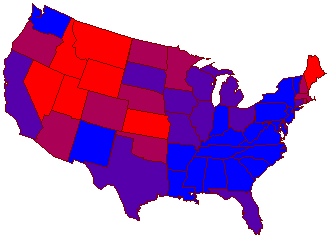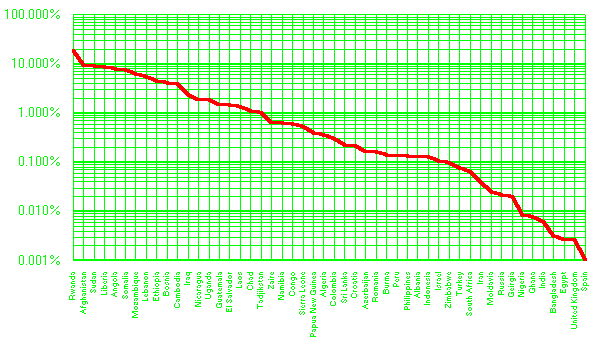
This scenario is not as totally impossible as some people might believe. In the range of improbability, it's more like a ten-to-one shot, rather than a hundred-to-one shot. In the early 1990s the USA probably came closer to open rebellion than at any time since the 1960s. In the 3 years from 1992 to 1995, the US saw:
What we need to do is crank up the Rage-o-Meter a few notches so that this era of grumbling leads to all-out civil war. Of course, I have no idea how to do this. None of the issues of the day seem to be worth dying over. I mean, let's have a show of hands: how many people would be willing to take a bullet in order to abolish/preserve affirmative action? I didn't think so.
Sure, taxes are a bit high, and they get squandered on useless activities, but for most of us, the government still leaves us enough for house, car, clothes, computer, gun, food, girlfriend, wife, both, TV, child or two, etc., and we get interstates and Internet in return.
The hard right seems to believe that Waco should have been a spark for rebellion, but it's not like any militiamen rushed to relieve the siege; however, let's pretend that they did. Let's say that discontent had gotten so bad by 1993 that we have the required 13% necessary to fight a successful guerrilla war. When the Feds surrounded the Branch-Davidian compound, militiamen spontaneously coalesce on the scene. Civil war erupts.
The most likely outcome of a war between the Feds and the extreme right is that the extreme right is crushed like bugs, even before the network news anchors can move their mobile newsdesks, satellite link-ups and tactical hairdryers out to the battlefield. To make it more interesting, however, let's suppose that there are enough rebels to make it drag on awhile.
A rough rule of thumb (from Liddell Hart [?] "Lessons from Resistance Movements -- Guerrilla and Nonviolent"[?]) is that a successful insurrection needs at least 3% of the adult population actively fighting the government, and another 10% supporting the rebels. In the US, that would be 5 Million armed and 19 Million in support. Who would they be?
Well, in our timeline, the discontent with the status quo showed up most noticeably in the Perot Campaign, so let's magically turn these 20M Perot voters into 24M rebels, roughly distributed the same, geographically. Although Perotistas were spread widely across the country, they were strongest in the Mountain Time Zone. Wait, I'm lying. The Perot vote was actually strongest in Maine, Alaska and Kansas which are not on Mountain Time, but the *NEXT* level down (@ ca. 25% of the vote) was a solid cluster of states in the area that Joel Garreau, in The Nine Nations of North America, labelled the Empty Quarter, a hotbed of anti-federalism.

My guess is that any insurrection in the early 1990s would be strongest here -- not as a secession of states (with control of the air, the Feds could easily drop the 82nd Airborne into any state capital), but there would be a solid guerrilla presence that required the Feds to travel in large convoys or not at all. This is good partisan country, with some 20M people scattered across rough territory, which makes up 30% of the area of the Lower 48. Let's say that some 2.5M of our rebels and 8.5M sympathizers would be in this zone. (With some 4 million too young to take sides, this would leave 9 million loyalists in this region.)
 |
| Guerrilla leader Jesse Ventura |
The other 13M rebels and sympathizers would be in smaller patches all over the country -the upper tier of New England, enclaves in the plains states, clusters of counties in the south, etc. There would be plenty of rural ambushes and urban bombings outside the Empty Quarter, but if the rebellion follows the same pattern as the Perot vote, then most of these remaining rebels (say 7.5M) would still be within a day's drive of the Empty Quarter. (Well, "a day's drive" today. In a war zone, there would be enough roadblocks and checkpoints to slow it down to 3-5 days)
On the whole, however, the Feds would probably keep control of all the cities. They would surely pack enough firepower to be able to travel wherever they chose. The rebels would melt away whenever a column approached, but they would pick off any sentries and small garrisons left behind, after the column had passed.
How many people would die in this rebellion? Well, I just happen to have on hand the death tolls from 50 civil wars fought during the period 1975-1999. Graphed as a percentage of the nation's total population, the death rates distribute like this:

If we take the middle half of our fifty civil wars (that is, numbers 13-38), and apply that range of percentages (.7% to 2%) to an American population of 250 million, then we see that there's a good chance that 175,000 to 5,000,000 people would die in a new American Civil War. The precise median death rate in our sample is 3500 per million, which therefore puts the likeliest body count at 875,000 Americans. Of course, there's a wide spread in the sample. A civil war of Afghan intensity would kill 25,000,000, while a Northern Irish death rate would kill only 15,000, but an average war, fought in a style similar to Nicaragua, Sri Lanka, Colombia, Peru or Algeria would certainly kill many hundreds of thousands.
So I guess we're lucky that this didn't happen.
| State | Perot's Percentage of Vote |
|---|---|
| Maine | 30 |
| Alaska | 28 |
| Kansas | 27 |
| Utah | 27 |
| Idaho | 27 |
| Nevada | 26 |
| Montana | 26 |
| Wyoming | 26 |
| Minnesota | 24 |
| Washington | 24 |
| Oregon | 24 |
| Nebraska | 24 |
| Arizona | 24 |
| North Dakota | 23 |
| Oklahoma | 23 |
| Vermont | 23 |
| Massachusetts | 23 |
| New Hampshire | 23 |
| Colorado | 23 |
| Rhode Island | 23 |
| South Dakota | 22 |
| Wisconsin | 22 |
| Missouri | 22 |
| Connecticut | 22 |
| Texas | 22 |
| Ohio | 21 |
| California | 21 |
| Delaware | 20 |
| Indiana | 20 |
| Florida | 20 |
| United States Average | 19 |
[back]
Last updated November 1999
Copyright © 1999 Matthew White